When you are about to start a garden, you have the choice of planting in raised beds or in-ground beds. No matter which you choose, your plants will be successful as long as the conditions for growth are met. However, both types of garden beds offer advantages.
But are raised beds better for gardening?
Raised beds can offer more advantages to you as a gardener. But this may depend on your individual wants and needs. Whether they are better than or equal too a standard garden depends on soil type, climate, and the types of plants you wish to grow in them.
For instance, raised beds allow you to practice intensive gardening within a small space.
Like we’ve just hinted, raised beds are great. But their superiority over in-ground beds depends on your own considerations.
In this article, we will compare and contrast raised beds and in-ground beds.
Table of Contents
The Benefits of Raised Bed Gardening
As the name reveals, a raised bed is a planting vessel containing soil at a level above the ground. You may create one using wood, bricks, stones, or synthetic lumber.
You may choose to make your raised bed into any size or shape. Some common dimensions are: 6 – 8 inches in height, 6 – 8 feet in length, and 4 – 6 feet wide
There are many advantages to opting for raised beds in your garden. They include the following:
Reduced Weed Growth
Vegetables are often planted intensively in raised bed gardens. When mature, vegetables can act as natural mulch for the soil with their abundant foliage.
The presence of any mulch on the soil surface reduces the chances of weeds growing in a raised bed.
When you mulch and care for the soil regularly, the chances of weeds growing reduces over time.
Also, soil compaction rarely happens in raised beds. One reason for this is that you do not walk on the soil.
Soil compaction can favor the growth of weeds. When it is lessened, the chances of weed growth are reduced.
Infrequent Maintenance
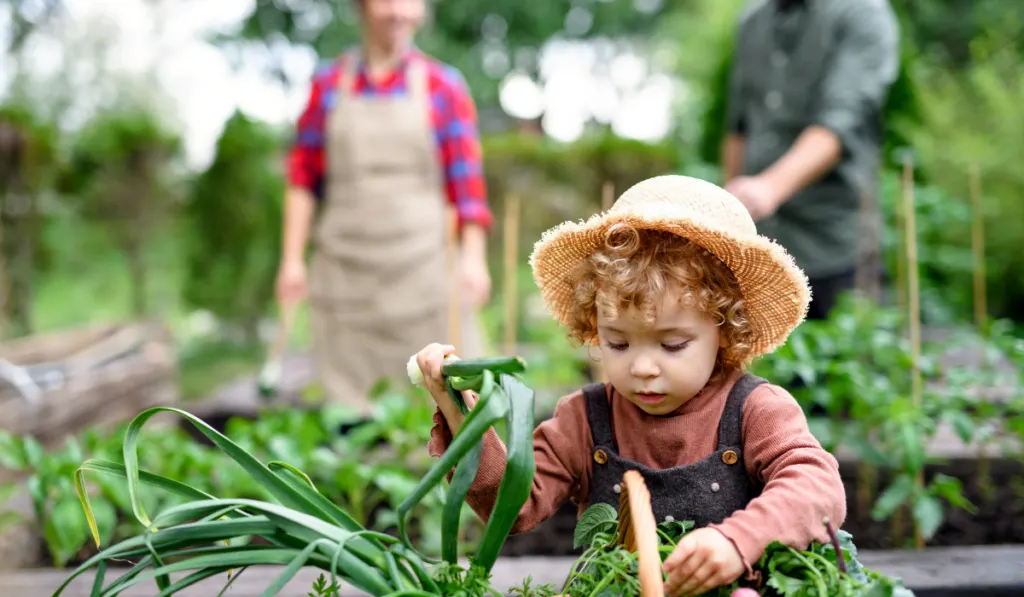
Lessened opportunity for soil compaction in raised beds also means that you would not have to till the beds.
As long as you prepare the soil with sufficient organic matter and regularly replenish it, you may never have to till the soil.
Plants Do Not Get Damaged
When planting in-ground, there is that risk of soil compaction, leading to reduced water permeability and aeration. These conditions can cause damage to plants and roots.
Since these factors are unlikely to happen in raised beds, plant damage is uncommon.
Maximized Space
When planting in rows, don’t forget to create paths for you to walk and move your equipment on.
But with raised beds, you need less space for walking paths. This extra space can be used in growing more plants.
Longer Growing Seasons
After winter, raised beds will warm faster, becoming ready for planting quicker.
In other words, during early spring, you can plant in raised beds earlier than in-ground beds, giving you a longer growing season.
Less Planting Materials Required
In raised bed gardening, you are planting many plants in a restricted space. Therefore, you’ll need less fertilizer, water, mulch, and other amendments to treat all of your plants at once.
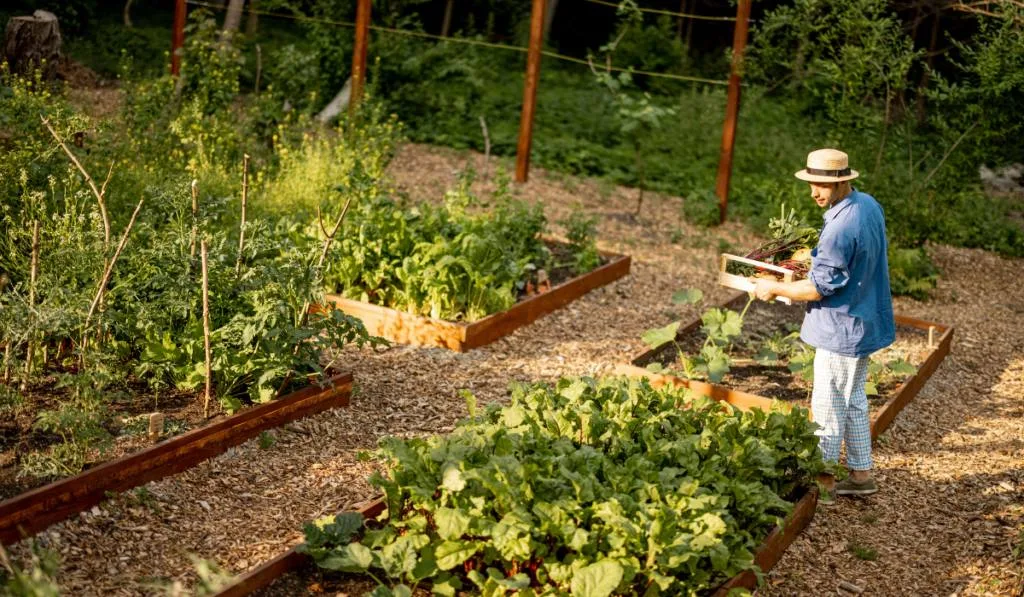
Easier Access
Perhaps the best thing about raised beds is the easier access that comes with the increased height off the ground. Besides being easily accessible to everyone, it is particularly helpful for those with physical limitations.
Raised beds are also great for people with back issues and those who do not like bending for long periods of time. Since the plants are at a higher level, they can be readily reached while standing or sitting.
Good Drainage
Properly prepared raised gardens usually drain very well. Good drainage is essential to the survival of plants.
Poorly drained soils will cause the roots of some plants to rot, and may even prevent seeds or transplants from growing in the first place.
In areas where poor drainage prevents you from planting certain types of plants, you may instead find luck growing them in raised beds.
Many vegetables do not grow well in poorly drained soil. This is one reason why they usually grow better in well-prepared raised beds.
Stable Soil pH
In raised bed gardens, the pH can be kept within a favorable range of 6 — 7, supporting the growth of many plants and vegetables.
Lower Chances of Erosion
Since the soil is confined within a frame, the chances of soil erosion in raised beds are greatly reduced.
Flexibility
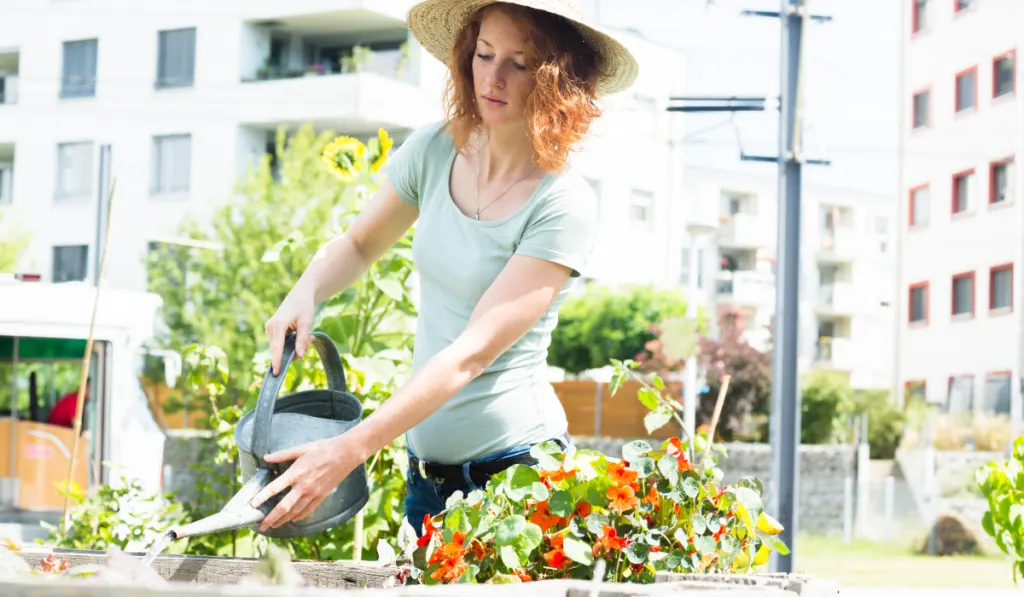
You can build raised beds in different types of spaces. You can build them on slopes, in parking lots, and in many other unconventional garden spaces.
The soil conditions in a location do not have to determine whether you can have a garden or not. Raised beds allow you to create the soil that meets the requirements for the plants you intend to sow.
Raised Bed Garden Design
Design is essential to the success of your raised bed. You should consider the following when designing your raised beds:
Bed Spacing
You should consider leaving at least 18 inches between each bed. This space will serve as the path through your garden. You may leave more space if you intend to move tools such as a wheelbarrow through the garden.
Bed Depth
The bed depth depends on the type of vegetables or plants you intend to grow in your garden. Generally, you should make the beds at least 6 inches deep.
For root vegetables, you should make the bed at least 10 – 12 inches deep. In some cases, your bed can be as deep as 24 inches.
Bed Width
You can make your bed any width, but 4 – 6 feet is common. Any wider and you may not be able to reach the center for weeding and harvesting.
Plant Spacing
You may choose to sow your plant in rows, or you may opt for square foot gardening.
In square foot gardening, you’ll divide the bed into 1 square-foot sections. Dedicate each section to one type of plant. Check the recommended spacing for each plant and use that when planting.

Frame
If you choose to make your beds with a wooden frame, opt for untreated, rot-resistant wood. Treated wood materials can leak toxins into the soil and should be avoided.
Besides wood, you may also use stone, bricks, aluminum, or woven twigs. If you build your frame with wood, fasten the corners together using galvanized screws. This type of screw is resistant to the elements.
If you are using stones or bricks, you may hold them together with mortar. Alternatively, you may do without it and dry lay them.
Bed Lining
Lining the base of the raised bed prevents any weeds in the ground from growing up through the soil.
You may use cardboard, cloth fabric, or landscape fabric to line the bottom of raised beds.
Never use non-porous material such as plastic. They will retain water and keep beneficial worms and insects away.
Watering
Raised beds usually need more water than in-ground beds, so you have to make provisions for sufficient watering.
You have 2 main options: manual watering and automatic irrigation.
With manual watering, you water the plants yourself with a watering can, a hose, or any other source of water. This method can be time-consuming, so you could consider automatic irrigation instead.
Automatic irrigation is run by a timer, and can be used with drip irrigation and soaker hoses. Once installed, the timer handles the watering, freeing you up for other things.
Soil for Raised Garden Beds
Filling your raised beds with the right soil is crucial to success. The two most essential components of the soil in a raised bed are topsoil and compost.
You may choose to prepare your soil using topsoil and compost in a 1:1 or 2:1 ratio, respectively. You could also add potting soil to the mix in a 6:3:1 ratio (topsoil: compost: potting soil).
You may choose to prepare your raised bed with soil from the surrounding environment, making use of soil that is already adapted to the weather in that location.
But in certain cases, the soil from your environment may not be great for planting. Then you should prepare your own.
Planning a Raised Bed Garden
When planning a raised bed garden, you should consider the following:
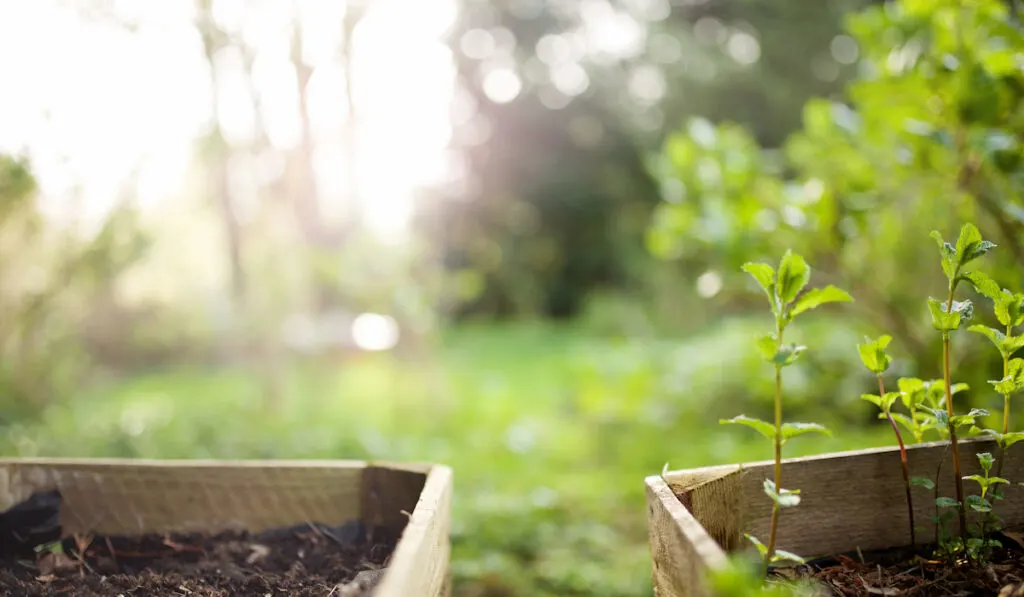
Sunlight
Your beds should be located where they receive sufficient sunlight. Take note that the amount of sunlight needed varies for each type of vegetable. Some vegetables require partial sunlight, some need full sunlight, while some require less.
Generally, root and fruit vegetables need about 6 – 8 hours of sunlight, while leafy vegetables need about 4 hours.
You should consider the type of vegetable you intend to plant and its sunlight requirement while choosing the location of the beds.
Calculate Quantity of Soil You Need
The quantity of soil you’ll need depends on the size and number of beds you intend to build. To calculate this, multiply the length, width, and depth of the bed.
For instance, if the length of a bed is 8 feet, the width is 4 feet, and depth is 1 foot, the quantity of soil you’ll need for that bed is 8 x 4 x 1 = 32 cubic feet.
Remember to determine the quantity of the soil you need in cubic feet, which is how soil is sold.
Timing and the Type of Plants to Grow
Timing is very important when planning your garden. Determine the average temperatures of your location, which will indicate the planting zone you fall in. This will help you decide the types of plants to sow during different seasons and when to plant them.
While most plants do well in temperatures between 60 and 70°F, some plants need lower or higher temperatures for survival. Consider these requirements when making your selections.
The average frost date of your planting zone is also important. Time your plants to be harvested before the first hard frost.
For example, if the maturity period of your plant is 30 days, sow it at least one month before the first hard frost date.
If you intend to practice succession planting, choose plants that have short maturity periods. Alternatively, you may use transplants.
Succession planting makes it possible for you to plant multiple crops in a bed within a single growing season.
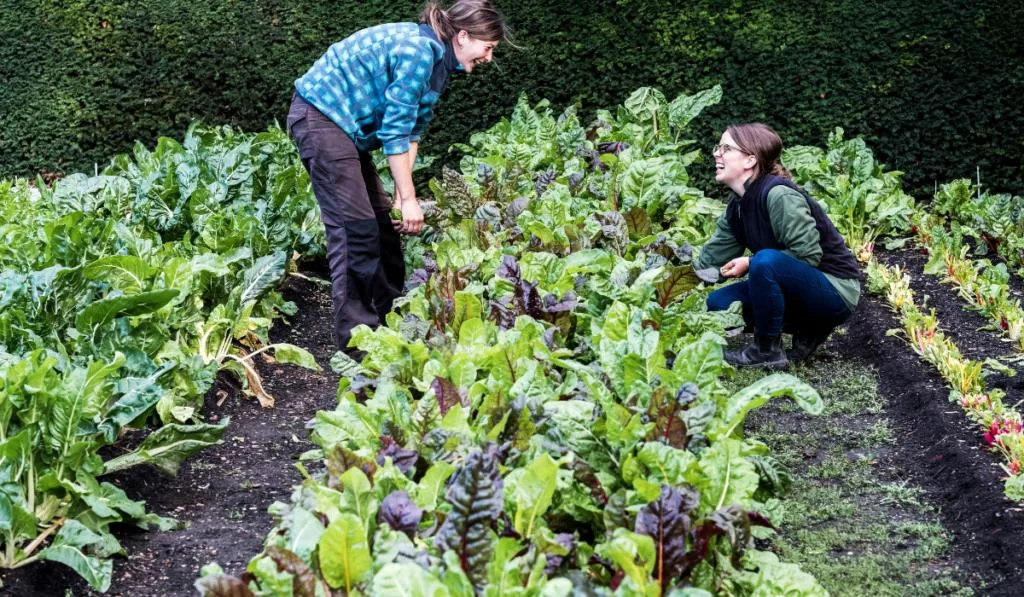
The Benefits of In-Ground Garden Beds
The following are some of the benefits that come with in-ground garden beds:
The Ability to Use Larger Farm Machines
In in-ground gardening, the soil is not confined within a frame, so large farm machines like tractors, plows, or rototillers can be used.
Less Work May be Required to Start
When practicing in-ground gardening, you don’t have to create frames for the beds. You may only have to water, till, and mulch the area.
This may be less work than you would have to do to start a raised bed garden.
Easier to Move and Replace
With in-ground beds, you can easily plant new crops in place of old crops. You may also choose to move to a new piece of land and sow your plants there.
Doing the same with raised beds won’t be as easy because you’ll have to uninstall and re-install the frames of the beds.
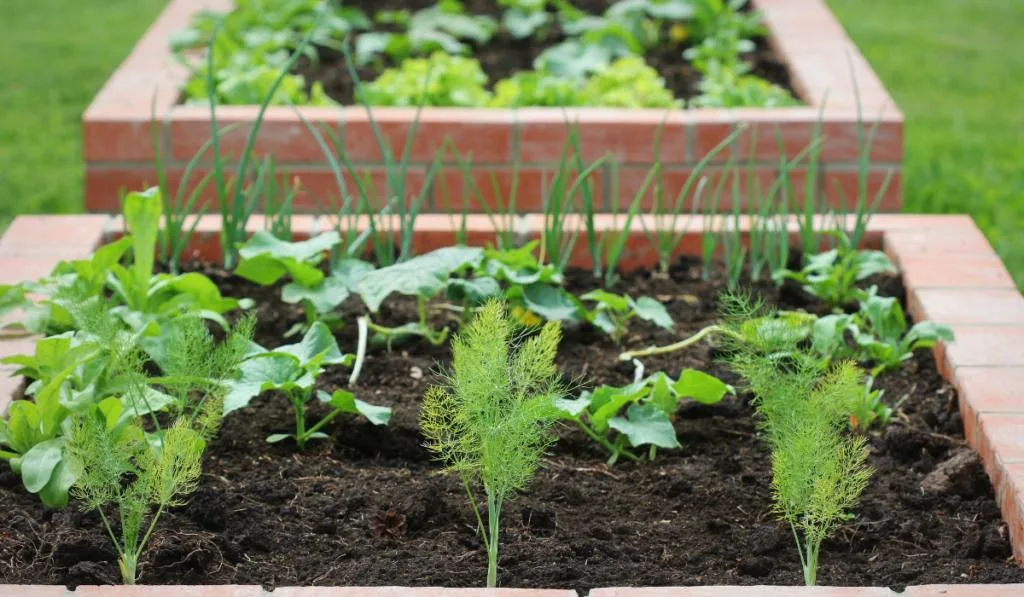
Lower Frequency of Watering
Raised beds lose water quicker compared to in-ground beds. In-ground beds may not require watering as much as raised beds.
No Preparation of New Soil
If you are practicing in-ground bed gardening, you may not have to prepare the soil from scratch.
Many times, the soil in the ground is already suitable. You may till, water, mulch, and amend to improve it. But you won’t have to source it completely as is often the case in raised bed gardening.
It Is Less Expensive
In-ground beds are cheaper for some reasons, including the following:
The soil is already in place, so you don’t have to spend money for it.
There is no cost for creating frames for your beds.
Then, you can apply the extra money to amendments for improving the soil.
Simple Irrigation System Design
Since the beds are flat on the ground, it is quite easy to design and install irrigation systems for in-ground beds.

Garden Design
The following are some things to consider while designing your in-ground beds:
Bed Spacing
Design your beds to allow sufficient movement between the beds. A space measuring 18 inches is enough for a walking path.
The spacing should be no less than the width of your wheelbarrow if you’ll be using one in the garden.
Walking Path
You could decide to install stepping stones for a walking path. Paths made of other materials reduce soil compaction.
Some options for path materials include gravel, clay bricks, pavers, bricks, pallet wood, and much more.
Bed Width
Try to avoid making the beds wider than 4 feet. The wider they are, the harder it is for you to reach across them.
Soil
If you get lucky, the soil in your garden may be usable from the start. But if it isn’t, you’ll have to amend it.
Add compost to the soil to increase organic matter, aeration, and drainage. Till the soil to improve aeration and drainage.
Soil aerators also help with soil aeration.
If the soil is contaminated, do not use it.
If the pH is too low, raise it with limestone or wood ash, but if it is too high, bring it down with sulfur or vinegar.
Planning
The same conditions that apply when planning raised garden beds apply to in-ground gardens. Plan the time at which you plant to coincide with the seasons.
Expose the plants to sufficient sunlight, and choose the plants that are best suited to your location.

Raised Bed vs. Row Gardening for Vegetables
Raised beds are the best for vegetables. Compared to row gardens, raised beds have better drainage. Since most vegetables do not thrive in wet soil, a raised bed is your best bet.
Pros and Cons of Each Garden Type
Pros and Cons of Raised Bed Gardens
| Pros | Cons |
| Fewer weeds | Do not support the use of large farm tools |
| Space is maximized | Require more money to start |
| Longer growing seasons | Cannot be moved easily |
| Infrequent maintenance | If done manually, watering can be time-consuming |
| Lower chances of plant damage | You have to prepare a new soil for each bed |
| More accessible | You need automatic irrigation for easy watering |
| Stable soil pH | |
| Good drainage | |
| Can be built in different types of spaces | |
| Lower chances of erosion | |
| Less planting materials |
Pros and Cons of In-Ground Garden Beds
| Pros | Cons |
| You can use large farm tools | Higher chances of weed growth |
| Easy to start | You may have to amend the soil frequently |
| You may not have to water as frequently | Higher chances of soil compaction |
| Less expensive to start | Higher chances of erosion |
| You may not have to prepare new soil | Higher chances of plant damage |
| Can easily be moved or replaced | |
| If watering less frequently, manual irrigation may be possible |
Conclusion
Raised beds offer many advantages, and the verdict on whether they are better depends on your needs and resources. If you intend to plant vegetables, raised bed gardens are certainly worth considering.
Resources
- https://extension.uga.edu/publications/detail.html
- https://savvygardening.com/weed-free-garden/
- https://www.finegardening.com/article/the-benefits-of-raised-garden-beds
- https://www.gardeners.com/how-to/raised-bed-basics/8565.html
- https://garden.lovetoknow.com/wiki/Winter_Georgia_Vegetables
- https://www.gardendesign.com/vegetables/raised-beds.html
- https://farmandgardendiy.com/how-much-sun-does-a-vegetable-garden-need/
- https://www.urdesignmag.com/architecture/2019/03/25/the-best-materials-for-walkways-and-paths/
- https://www.bobvila.com/slideshow/the-right-path-15-wonderful-walkway-designs-44301
- https://bonnieplants.com/gardening/how-to-plant-an-in-ground-garden-its-easy/
